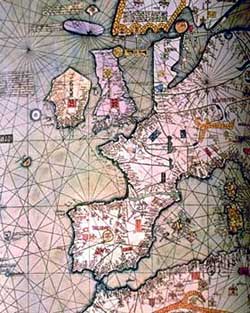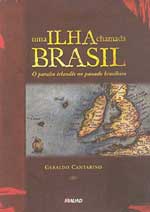|
Introduction
|

Catalan Atlas by Abraham Cresques,
showing Hy-Brassil west of Ireland, 1375
(Bibliotèque Nationale, Paris) |
This lecture, held in the National Library of
Ireland Ms. 13,087(31), was written by Roger Casement during
his time as a British consul in Belém do Pará at the mouth of
the Amazon sometime during 1907-1908.
[1] In broad terms it
puts forward an argument that the origins of the name Brazil
derive from the mythical Hy-Brassil. This imagined island,
located to the west of Ireland, is variously described as a
'promised land', the island of the blesséd - Tír na nÓg - the
land of the setting sun, and features most largely in the
voyages of St Brendan.
[2]
In arguing such a root, Casement was current
with Irish historical study of the day. He believed that
Hy-Brassil was a name derived from the legends of the Atlantic
sea-board, with Celto-Iberian origins dating from 'Atlantis
and the submerged mother-land of the early Irish, Iberians and
possibly Phoenicians'.
The name Brazil as a surname is current and
common to both Ireland and Portugal today and in Irish place
names such as Clanbrassil. Certainly 'Brazil', in a number of
variant spellings, can be found in several ancient Irish
manuscripts. 'Breasail' is the name used for a pagan demigod
in Hardiman's History of Galway. Another possible derivation
is from St Brecan, who shared the Aran islands with St Enda
about 480 or 500 and was originally called Bresal. The name
appears to have been built upon two Gaelic syllables 'breas'
and 'ail'.
On a number of medieval maps Brazil also
appears as the name for a land south west of the Skelligs.
Elsewhere, it is one of the islands of the Azores, possibly
Terceira. The earliest map is one drawn by Angellinus Dalorto
of Genoa in 1325, where Brazil appears as a large disk of land
to the south of Ireland. But on many later Italian and Catalan
maps the name frequently reappears.
[3]
|

Geraldo Cantarino's Uma ilha chamada
Brasil: o paraíso irlandês no passado brasileiro
(2004) is the most authoritative recent work on
the
subject of Hy-Brassil. |
Before setting out for America in 1492,
Columbus is alleged to have said, when pointing at the Isle of
St Brendan on Toscanelli's map: 'I am convinced that the
Earthly Paradise is on the isle of St. Brendan, which nobody
can reach save by the will of God.'
In looking
at how the Irish origins of Brazil had been written out of the
history books, Casement was able to show how the Anglo-Saxon
interpretation of history had obscured and corrupted the
history rooted in a more ancient Irish origin. It gave him the
chance to analyse the orthodox view of 'discovery' history and
a group of historians who, he felt, had neglected the Irish
influence in Atlantic culture through their ignorance of the
Irish language and their denial of a more ancient and mystical
source of knowledge.
Angus Mitchell
(*)
Anyone wishing to quote from this document should seek
permission from the Department of Manuscripts, National
Library of Ireland, Kildare Street, Dublin. |




